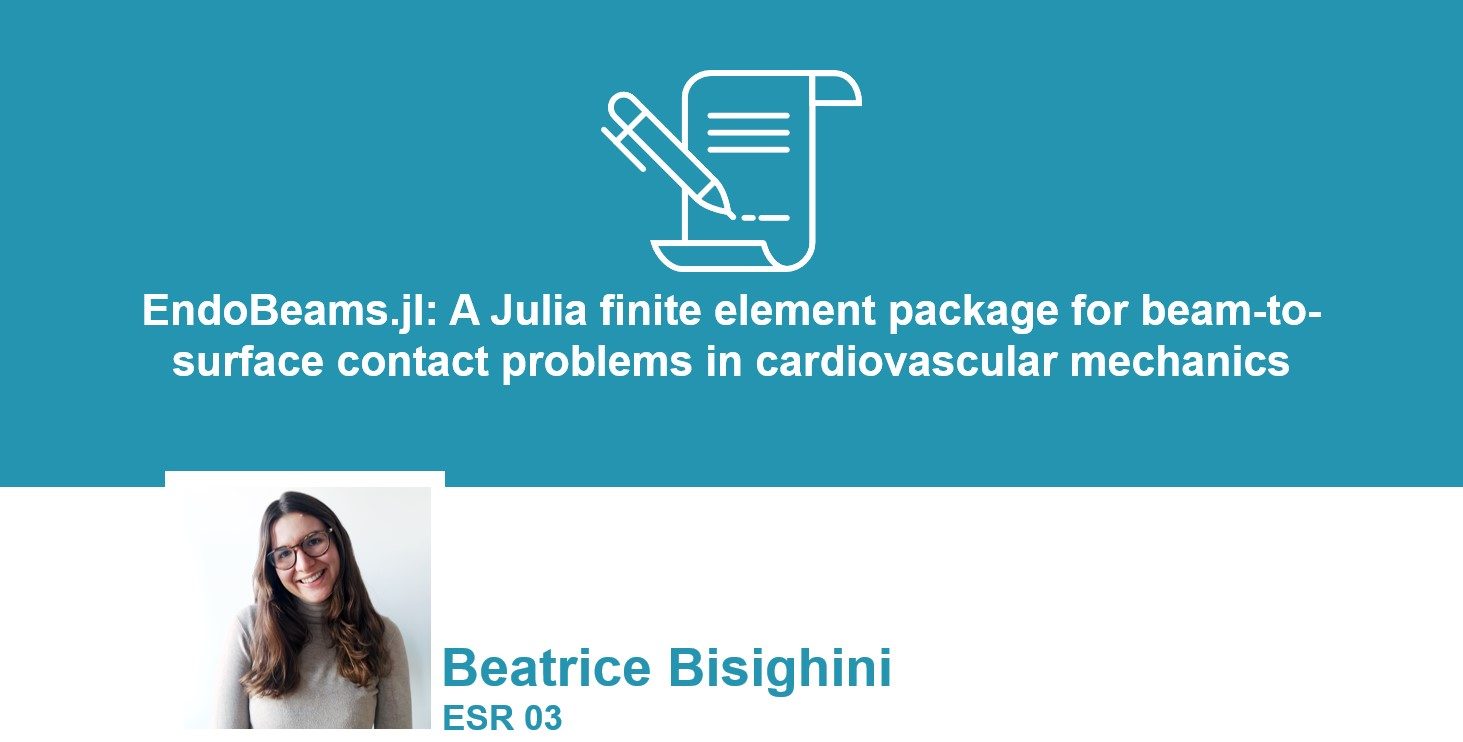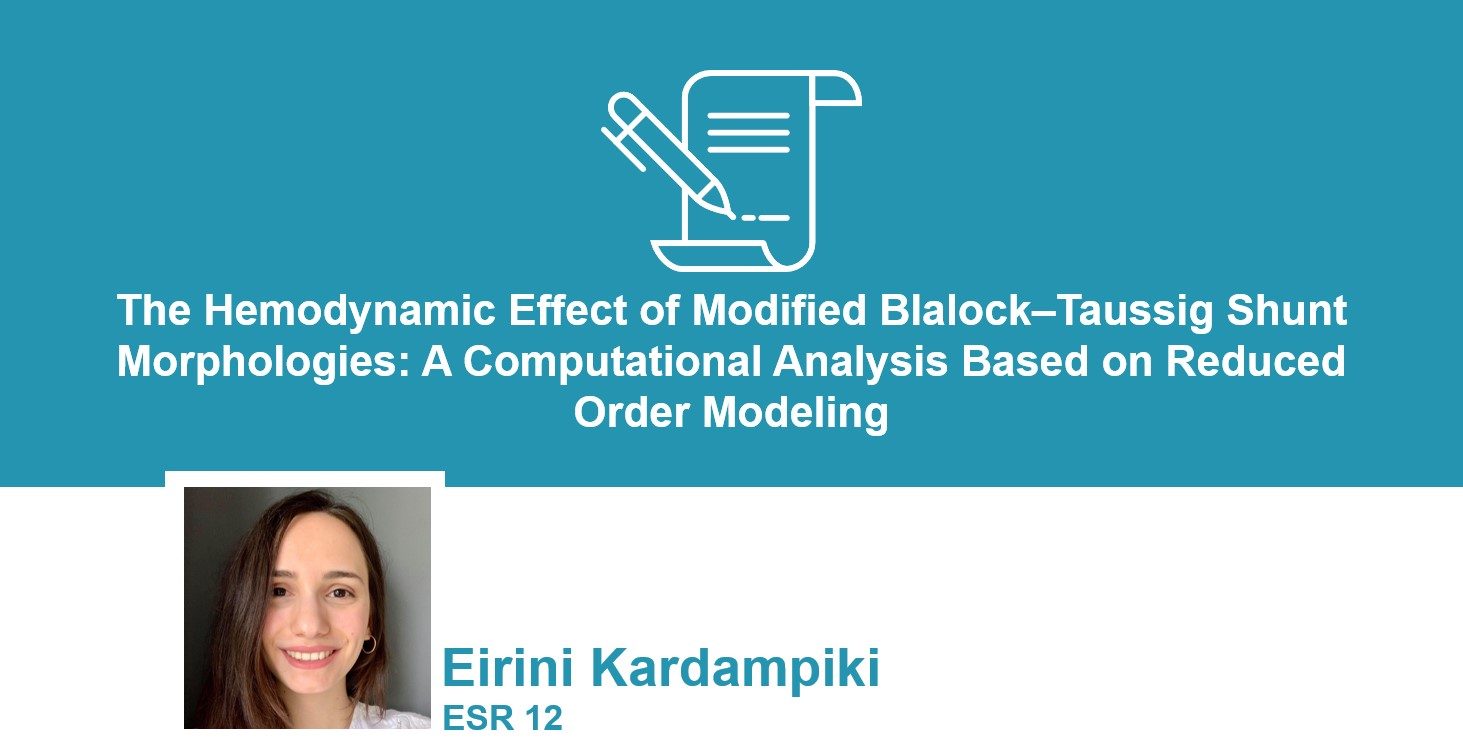Latest publication in MeDiTATe project. EndoBeams.jl: A Julia finite element package for beam-to-surface contact problems in cardiovascular mechanics

Beatrice Bisighini, ESR 03 in the MeDiTATe project, published the paper titled EndoBeams.jl: A Julia finite element package for beam-to-surface contact problems in cardiovascular mechanics on Advances in Engineering Software journal.
The work was developed in collaboration with Miquel Aguirre, Baptiste Pierrat and Stéphane Avril from Mines Saint-Étienne and David Perrin from PrediSurge.
The paper, whose abstract is reported in the following lines, is available at this link.
The increasing use of mini-invasive and endovascular surgical techniques is at the origin of the pressing need for
computational models to support planning and training. Several implantable devices have a wire-like structure,
which can be modelled using beam elements. Our objective is to create an efficient Finite Element (FE) modelling
framework for such devices. For that, we developed the EndoBeams.jl package, written exclusively in Julia, for
the numerical simulation of contact interactions between wire-like structures and rigid surfaces. The package is
based on a 3D FE corotational formulation for frictional contact dynamics of beams. The rigid target surface is
described implicitly using a signed distance field, predefined in a volumetric grid. Since the main objective
behind this package is to find the best compromise between computational speed and code readability, the al-
gorithm, originally in Matlab, was translated and optimised in Julia, a programming language designed to
combine the performance of low-level languages with the productivity of high-level ones. To evaluate the
robustness, a set of tests were conducted to compare the simulation results and computational time of Endo-
Beams.jl against literature data, the original Matlab code and the commercial software Abaqus. The tests proved
the accuracy of the underlying beam-to-surface formulation and showed the drastic performance improvement of
the Julia code with respect to the original one. EndoBeams.jl is also slightly faster than Abaqus. Finally, as a proof
of concept in cardiovascular medicine, a further example is shown where the deployment of a braided stent is
simulated within an idealised artery.
MeDiTATe project new publication. The Hemodynamic Effect of Modified Blalock–Taussig Shunt Morphologies: A Computational Analysis Based on Reduced Order Modeling

Eirini Kardampiki, ESR 12 in the MeDiTATe project, published the paper titled The Hemodynamic Effect of Modified Blalock–Taussig Shunt Morphologies: A Computational Analysis Based on Reduced Order Modeling on Electronics Journal from MDPI.
The work was developed in collaboration with Emanuele Vignali and Simona Celi from BioCardioLab (Fondazione Toscana G. Monasterio), Dorela Haxhiademi from Critical Care Unit (Fondazione Toscana G. Monasterio), Duccio Federici from Paediatric Cardiosurgery Unit (Fondazione Toscana G. Monasterio). A further contribution was given by Edoardo Ferrante, Margherita Cioffi and Emiliano Costa from RINA, Stefano Porziani and Andrea Chiappa from RBF Morph, Corrado Groth and Marco Evangelos Biancolini from the Department of Enterprise Engineering (University of Rome Tor Vergata).
The paper, whose abstract is reported in the following lines, is available at this link.
The Modified Blalock Taussig Shunt (MBTS) is one of the most common palliative operations in case of cyanotic heart diseases. Thus far, the decision on the position, size, and geometry of the implant relies on clinicians’ experience. In this paper, a Medical Digital Twin pipeline based on reduced order modeling is presented for fast and interactive evaluation of the hemodynamic parameters of MBTS. An infant case affected by complete pulmonary atresia was selected for this study. A three-dimensional digital model of the infant’s MBTS morphology was generated. A wide spectrum of MBTS geometries was explored by introducing twelve Radial Basis Function mesh modifiers. The combination of these modifiers allowed for analysis of various MBTS shapes. The final results proved the potential of the proposed approach for the investigation of significant hemodynamic features such as velocity, pressure, and wall shear stress as a function of the shunt’s morphology in real-time. In particular, it was demonstrated that the modifications of the MBTS morphology had a profound effect on the hemodynamic indices. The adoption of reduced models turned out to be a promising path to follow for MBTS numerical evaluation, with the potential to support patient-specific preoperative planning.
Recent Posts
- MeDiTATe final video: results
- Leonardo Geronzi ESR 02 of the MeDiTATe Project among Forbes Italia’s Top 100 Under 30
- Monica Emendi successfully defended her PhD thesis defense
- Martino Andrea Scarpolini successfully defended his PhD thesis defense
- Eirini Kardampiki successfully defended her PhD thesis defense
Archives
- June 2024
- March 2024
- February 2024
- December 2023
- October 2023
- September 2023
- August 2023
- July 2023
- June 2023
- May 2023
- April 2023
- March 2023
- February 2023
- January 2023
- December 2022
- November 2022
- October 2022
- September 2022
- August 2022
- July 2022
- June 2022
- May 2022
- April 2022
- March 2022
- March 2021
- February 2021
- December 2020
- November 2020
- February 2020
- January 2020

